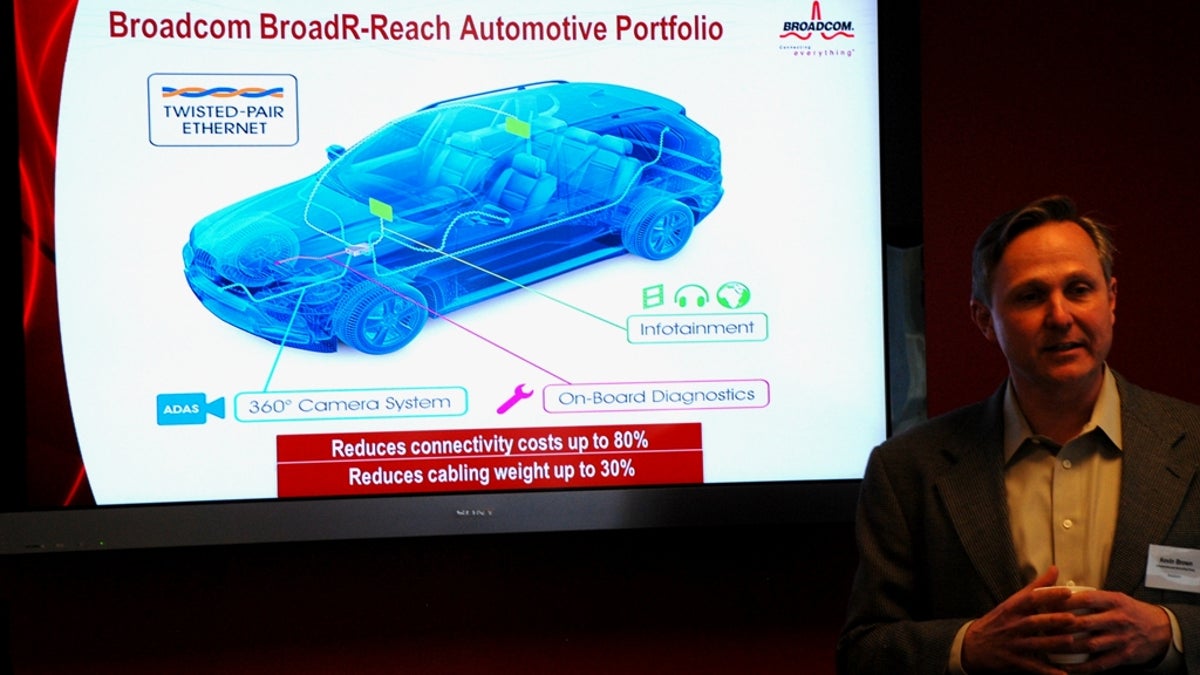Heading to CES, Broadcom talks 802.11ac, brings Ethernet to cars
Heading to CES 2012, Broadcom shows off a new networking application and technology for consumers to use at home, on the go, and on the road.

Your wireless network at home, and possibly in your car, is about to get a huge dose of networking supercharge.
In a pre-CES meeting with the press today, Broadcom, maker of chipsets that power popular networking devices, unveiled its plan for the new Wi-Fi specification, called 802.11ac, and demoed its new development in in-car Ethernet cabling technology.
The 802.11ac specification--an industry wireless networking standard confirmed by the Institute of Electrical and Electronics Engineers (IEEE) back in January--is the upgrade to the existing 802.11n specification and is considered by Broadcom to be the standard for the "post-PC era" of data connectivity. Broadcom cited a report saying that currently 55 percent of wireless clients are non-PC, which includes game consoles, set-top boxes, and mobile devices.
Unlike 802.11n, which is available in both the 2.4GHz and 5GHz bands, the new 802.11ac uses only the 5GHz band and incorporates many standardized techniques that help greatly increase both the data rates and wireless range. It's also backward-compatible with 802.11n clients. According to Rahul Patel, vice president of Broadcom's Mobile and Wireless Group, Broadcom's new 802.11ac chips will offer the following benefits.
Much improved wireless performance: Similar to the previous 802.11n standard, the 802.11ac works in 1-by-1, 2-by-2, and 3-by-3 antenna configurations. However, even in the lowest 1-by-1 configuration (used mostly for mobile clients, such as smartphones and tablets), the max throughput speed is rated at 450Mbps, which is as fast as the current top speed offered by the 3-by-3 configuration of existing 802.11n routers, such as the Linksys E4200. In a 3-by-3 configuration, often used for routers and computers, the maximum data rate is roughly 1.4Gbps, faster than a Gigabit Ethernet connection.
"Technically, you can put more antennas together in a 4-by-4 or 5-by-5 configurations to get even higher bandwidth, but due to design and power constraints, we'll likely stay at 1.4Gbps for now," Patel said.
Broader coverage and higher capacity: One of the hurdles of 802.11n, especially 2.4GHz, is that this band is shared by many wireless devices and therefore is subject to a large amount of interference, which translates to lower-than-expected performance. The new 802.11ac uses only the 5GHz band, which is cleaner. It's capable of using wider bandwidth (up to 160MHz, as opposed to the 40MHz of 802.11n), up to eight MIMO spatial streams, multiuser MIMO, and standardized beamforming. All those hard-to-understand techniques mean that 802.11ac devices will have at least twice the range of existing 802.11n devices and many more existing devices will be able to share one physical space before interference occurs.
Note that beamforming has been available in select 802.11n routers, but with 802.11ac, the technology has been standardized, meaning it'll be available in all 802.11ac devices.
Better battery life: According to Patel, the improvement in battery life of a 802.11ac client is a linear result of its performance. Basically, since it's much faster, the client has to work for a shorter time to transmit or receive the same amount of data as an 802.11n client. This means there's more idle time, which translates into less energy being used.
On the car front, Kevin Brown, vice president and general manager of the Infrastructure and Networking Group, announced that Broadcom has been working with a number of carmakers to incorporate twisted-pair Ethernet cabling in cars to replace some of the traditional wiring that's more expensive and adds more weight to the car. One application involves the video camera used for parking or when driving the car in reverse. According to Brown, using Ethernet, car manufacturers can save up to 80 percent of connectivity costs while reducing the cabling weight up to 30 percent.
Broadcom also demoed a new at-home connectivity concept that allows users to receive content from multiple sources, including up to eight channels of digital TV, and broadcast them in real time to different TVs around the home via different types of connectivity.
Broadcom says it will show the same and other "more exciting demos" at CES 2012, in case you're in Las Vegas during the second week of the new year. If not, check back at CNET.

